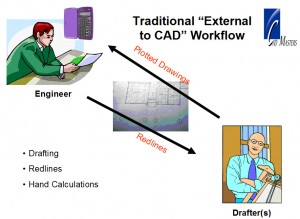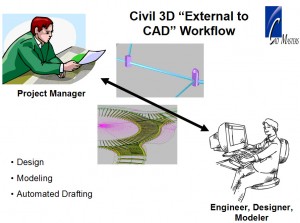Death of the Draftsman?
A skilled draftsman combines artistry with precision. A skilled draftsman will not only deliver a drawing that is legible and precise, but also readable. I’ve seen plenty of drawings that are legible and precise, but are not necessarily readable. A readable drawing will have an artistic quality that better conveys the designer’s intent.
But as we take a look at the progress of Autodesk software, I wonder if we are seeing the Death of the Draftsman? With Autodesk BIM products like Revit and Civil 3D, the intent is to model and not necessarily draft. Instead of drawing two lines to draw a wall, it’s modeled. Instead of drafting a pipe and annotating its slope, model the pipe and set the slope as a property.
When I prepare clients for implementation of Civil 3D, I show them the following two slides. Here’s my slide for the traditional workflow process:
Here’s my slide for, quite possibly, their future workflow process:
Notice several differences between the two slides. Most importantly, the draftsman has become (or been replaced by) an engineer, designer, or modeler.
My point behind the slides is that implementing new software requires more than templates, standards, families and training. Clients must review their current “external to CAD” workflow and determine if changes need to be made for successful implementation. Some clients are still at the first slide, while others are at the second.
But back to the question, are we seeing the Death of the Draftsman with BIM products? Let us know what you think.




DEATH of the Draftsman…INDEED. Centered atop my dual flat screen monitors, sits a wooden architectural scale which has an inscription scrawled into it “JTM 1974”. It was given to me by my 7th grade drafting instructor. As I write this blog, I just happened to gaze down at the middle finger of my right hand. There is my ever present Drafters Lump. I used to call it my Kohinoor Kiss, fondly commemorating my cobalt blue Kohinoor lead holder that allowed me to make a living and to enjoy the fruits of my labor. Pushing lead, wiping off eraser dust and graphite dust was an everyday affair at one point in my life. It wasn’t always fun, but there were moments, for instance if I ran out of tape to hold down my drawing. I sometimes had to get creative ….Bazooka Time (if your old enough to know what that is). I treasure those times of tactile simplicity and the awesome gratification of completing that ten sheet isometric assembly package that I created with my own hand. Death of a draftsman …..NEVER !!!!! Oh wait…the power flickered here…better get a piece of paper and my Pentel 0.7mm and finish this blog. I can post after the power is restored.
I was one of the earliest implementers of CADD (yes, that was still when there was a second “D” in the acronym) in the Sacramento area nearly 30 years ago. I recognized the need to teach the designers on how to use the system to help reduce the red-marking cycle. The concept is grand, but the implementation is difficult. Two critical issues obstructing change, one was human nature to resist change and two was the software’s ease of use and lack of intuitiveness (i.e. cumbersomeness in creating the graphics = a tremendous amount of training/coaching is required).
From what I have seen, not much has changed … human nature is still resistant to change and while the software has gotten more sophisticated, it still is extremely cumbersome and non-intuitive to use. I’d be surprised to see a “non-draftsman” office happen within my lifetime.
Don’t even get me started on the costs for all of these wonderful tools.
I’m 61. Did you have to use the word “death” for draftsman types? How about “fond memories”?
I’ve been telling that to our engineers for years.
On one hand, in the professional realm, the “kids” coming out of school now, our future engineers are learning – and using (properly) – CAD programs, so that instead of telling a draftsman what they want and doing the old back and forth till it’s right (or close enough, in many cases) dance, they can just do it themselves.
And because they know what it is they actually want they can make it a closer match to their intended ideas.
– On the other hand, draftsmen will never really be gone because there are plenty of people with ideas that don’t know how to draw that will need our services.
– Personally, I’m planning on retiring at about the same time the “change” happens so as not to be left hungry.
I sure hope not!
When I finished tech school with my mechnical designer ticket the first job I got was in a model shop. We were working on nuke plants and what fun we had. Then that pesky computer came along and that job went the way of the buggy whip makers.
Drafting was and is a skilled job. Not every engineer can draw there way out of a paper bag no mater what tool they use. I know and have worked for several.
I think the real question is are you willing to make the change to make things better or do you want to keep makeing a product that nobody wants.`
Skillsets must be increased as time goes on. Retirement No ,this is fun.
What happened to the Drafter, Draftsman, Draughtsman, Designer, Design Drafter or even the Chief Drafter? They are still alive and well. After 36 years in the craft, you have to understand only the titles have changed. CADD (Computer Aided Drafting and Design) the accurate name, is only an electronic drawing board, nothing more or less.
The computer will not automatically do anything. An operator must understand the proper way to construct a drawing, line weights, understand dimensioning rules and procedures, symbolism for materials, all the drafting rules, theories and principles related to the profession. Over the last twenty years we have seen the “boom” of CAD Operators or “Jockies” flood the market. These individuals are almost experts in System Operations but are always 100% when it comes to the knowledge of creating a drawing which meets the required standards of the profession. This has related to old drafters, like all of you, consistently reviewing and marking drawing to reflect the requirements set forth by the related industry.
There is hope. As Executive Director of the American Design Drafting Association a 501c3 Professional Membership and Educational Association we have good news. Many State Departments of Education are now requiring standardized curriculum for the classroom which meets or exceeds the standard set by industry. ADDA has been involved in this process for many years and we seeing improvement in the NEW Professional. With the schools who are actively improving the instructional methods the program graduates are being made aware that drafting is a visualization of a product and their job is to descriptively and graphically communicate how the item is to be build or manufactured using core drafting principles, industry standards, building codes and manufacturing requirements.
Currently ADDA assists in this process with Professional Certification Examination which are offered in several disciplines at the Apprentice and Drafter levels. The Certifications can be used by Educational Facilities or Industry Professionals. The exams are difficult, challenging and take up to 3 hours to complete. Based on the discipline, the exams cover 15 to 20 competencies. ADDA has over 1000 members and has certified over 6000 professionals in the last 15 years.
ADDA is a very well kept secret. We have been around since 1948.. CADD put a hardship on us, but we pushed the need for proper education, teaching of the standards and implementing the need for professional training. We stood the ground which held the core of our profession. It was difficult, but we still here, working for and with the profession every day. The drafter is not dead, they do their job, kept quite and continue to WOW all those who see a “True Craft” represented by skill and perfection. We are a Legacy of Excellence… communicated in everything that is created.
Well said. The drafter is still alive, just in a different form.
If the Draftsman is not yet dead…then why is there so much…emphasis…so much drafting equipment on ebay and other sites? I realize progress is important and all that…the computer has no soul…no spirit…no talent…is that progress? I find it somewhat sad that the equipment I once would have given almost anything to have to improve my quality of work is now being auctioned off for practically nothing. I am sure there are draftsman around yet today but as a choice for a career…it seems doomed.
I was a draughtsman for maany years.In mechanical engineering the draughtsman has to have a vision of what is to be drawn and necessary detail to be drawn to enable manufacture.This skill is also necessary for CAD.I believe there are exellent draghtsmen around who know how to use a pencil but not accomputer.Such a pity this talent is being lost.